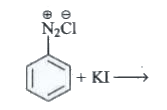Benzophenone can be obtained by ……
benzoyl chloride+benzene+AlCl3
benzoyl chloride+diphenyl cadmium
benzoyl chloride+phenyl magnesium chloride
benzene+carbon monoxide+ZnCl2
The correct Answer is:A
To determine how benzophenone can be obtained, we will analyze the provided options step by step.
Step 1: Understand the Structure of Benzophenone
Benzophenone has the structure of two benzene rings (C6H5) connected by a carbonyl group (C=O). Its chemical formula is C13H10O.
Step 2: Analyze Option A
Option A: Benzoyl chloride + Benzene + AlCl3
- Benzoyl chloride (C6H5C(=O)Cl) is a reactive acyl chloride.
- Aluminum chloride (AlCl3) acts as a Lewis acid and facilitates the Friedel-Crafts acylation reaction.
- In this reaction, benzoyl chloride reacts with benzene in the presence of AlCl3, leading to the formation of benzophenone through the following steps:
1. AlCl3 coordinates with the chlorine atom of benzoyl chloride, forming a complex.
2. The complex generates a highly reactive acylium ion (C6H5C+=O).
3. The acylium ion attacks the benzene ring, leading to the formation of benzophenone and HCl as a byproduct.
Conclusion for Option A: This method successfully produces benzophenone.
Step 3: Analyze Option B
Option B: Benzoyl chloride + Diphenyl calcium
- Diphenyl calcium is a compound that can provide phenyl groups.
- The reaction proceeds similarly to Option A, where the phenyl group from diphenyl calcium attacks the carbonyl carbon of benzoyl chloride, leading to the formation of benzophenone.
- The chloride ion is eliminated in the process.
Conclusion for Option B: This method also successfully produces benzophenone.
Step 4: Analyze Option C
Option C: Benzoyl chloride + Phenyl magnesium chloride
- Phenyl magnesium chloride (C6H5MgCl) is a Grignard reagent.
- In this case, the nucleophilic phenyl group is not stable enough to effectively attack the carbonyl carbon of benzoyl chloride.
- As a result, this reaction does not yield benzophenone.
Conclusion for Option C: This method does not produce benzophenone.
Step 5: Analyze Option D
Option D: Benzene + Carbon monoxide + ZnCl2
- This reaction resembles the Kolbe electrolysis and is not suitable for forming benzophenone.
- Instead, it leads to the formation of benzoic acid.
Conclusion for Option D: This method does not produce benzophenone.
Final Conclusion
The methods that can produce benzophenone are:
- Option A: Benzoyl chloride + Benzene + AlCl3
- Option B: Benzoyl chloride + Diphenyl calcium
Summary of Correct Options
The correct options for obtaining benzophenone are A and B.
---
Benzophenone has the structure of two benzene rings (C6H5) connected by a carbonyl group (C=O). Its chemical formula is C13H10O.
Option A: Benzoyl chloride + Benzene + AlCl3
- Aluminum chloride (AlCl3) acts as a Lewis acid and facilitates the Friedel-Crafts acylation reaction.
- In this reaction, benzoyl chloride reacts with benzene in the presence of AlCl3, leading to the formation of benzophenone through the following steps:
1. AlCl3 coordinates with the chlorine atom of benzoyl chloride, forming a complex.
2. The complex generates a highly reactive acylium ion (C6H5C+=O).
3. The acylium ion attacks the benzene ring, leading to the formation of benzophenone and HCl as a byproduct.
Option B: Benzoyl chloride + Diphenyl calcium
- The reaction proceeds similarly to Option A, where the phenyl group from diphenyl calcium attacks the carbonyl carbon of benzoyl chloride, leading to the formation of benzophenone.
- The chloride ion is eliminated in the process.
Option C: Benzoyl chloride + Phenyl magnesium chloride
- In this case, the nucleophilic phenyl group is not stable enough to effectively attack the carbonyl carbon of benzoyl chloride.
- As a result, this reaction does not yield benzophenone.
Option D: Benzene + Carbon monoxide + ZnCl2
- Instead, it leads to the formation of benzoic acid.
The methods that can produce benzophenone are:
- Option A: Benzoyl chloride + Benzene + AlCl3
- Option B: Benzoyl chloride + Diphenyl calcium
The correct options for obtaining benzophenone are A and B.
Topper's Solved these Questions
- BOOK - NCERT EXEMPLAR ENGLISHCHAPTER - ALDEHYDE, KETONES AND CARBOXYLIC ACIDSEXERCISE - Short Answer Type Questions28videos
ALDEHYDE, KETONES AND CARBOXYLIC ACIDS
- BOOK - NCERT EXEMPLAR ENGLISHCHAPTER - ALDEHYDE, KETONES AND CARBOXYLIC ACIDSEXERCISE - Long Answer Type Questions4videos
ALDEHYDE, KETONES AND CARBOXYLIC ACIDS
- BOOK - NCERT EXEMPLAR ENGLISHCHAPTER - ALCOHOLS, PHENOLS AND ETHERSEXERCISE - All Questions74videos
ALCOHOLS, PHENOLS AND ETHERS
- BOOK - NCERT EXEMPLAR ENGLISHCHAPTER - AMINESEXERCISE - LONG ANSWER3videos
AMINES
Similar Questions
Knowledge Check
- Question 1 - Select One
Benzene can be obtained by :
AC6H5OH+NaOHCuO−−→ΔBC6H5OH+ZnΔCC6H5−N=N−Cl+H2O→DAll of these - Question 2 - Select One
Acetophenone can be obtained by the distillation of
A(C6H5COO)2CaB(CH3COO)2CaC(C6H5COO)2 and(CH3COO)2CaD(C6H5CO)2Ca and (HCOO)2Ca - Question 3 - Select One or More
Iodobenzene can be obtained by :
A B
B C
C D
D

